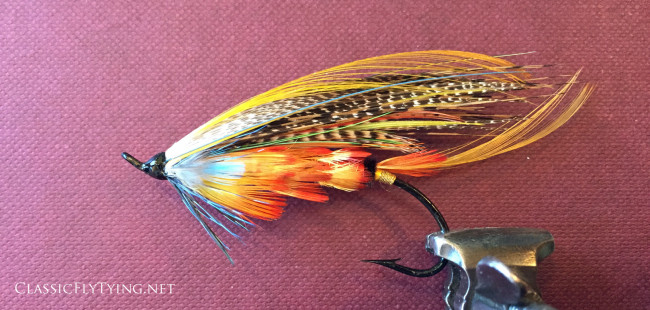It isn’t long after one starts on their journey into the world of the classic Salmon fly, that words such as endangered, rare, and expensive present themselves. It was a big surprise for me, that the Convention of International Trade of Endangered Species, CITES in short, was established as a result of the fly tying community, bringing the Grey Jungle Fowl to the brink of extinction. Before I read this, I had no clue that fly tying could have such a devastating impact on wild life. To me, this was an eye opener.
Exotic feathers appeal to us, because of their beauty and brightness. It is easy to understand why these materials have always been in popular demand. Certain materials sell a fly to a fisherman, while others offer the best contrast under water, potentially appealing to the fish. Contrary to popular belief, however, many of these materials have always been in short supply. It was only since the Golden Pheasant was domesticated, that tails, tippets and crests became affordable and readily available. Initially, these materials were more expensive, and harder to find, than for example Blue Chatterer.
Unfortunately, domestication doesn’t always work. The Red Ruffed Fruit Crow, Arabian Bustard, Bengal Florican, Western Tragopan, are all examples of birds that are much in demand, but won’t breed in captivity. When we purchase materials from endangered species, we contribute to increased demand, because we put the materials on display through our work. It is this ethic principle that deserves careful consideration, because if this is true for rare materials, it could also be true for sustainable materials, such as substitutes for materials from endangered species.

Sustainable Popham, using Ryan Houston’s IC subs and Kingfisher…
Substitutes are Becoming Popular
When thinking about substitutes, we no longer think that they are inferior. Many kinds of Indian Crow and Toucan subs – for which the tutorials are available on this website – show us that substitutes can be equal to originals. Substitutes are also a common traditional practise. Gallina dyed blue is used as a Jay substitute when longer fibers were required. Cotinga, never in great supply, was often replaced with Kingfisher, though Cotinga was also the substitute when Kingfisher was hard to come by. Banded Gymnogene was a substitute for Teal hackles on large flies, and the Hardy Brothers used Orange Weaver feathers to substitute Indian Crow on commercial flies. One thing that these traditional substitutes have in common, is that they all did a wonderful job in the water. Therefore, fishermen had faith in them, and so should we.
Identifying Potential Substitutes
There are two ways to substitute a feather. We can find natural feathers that are a close enough match, or we can take a completely different material, and process it to our need.
It is important that a substitute feather offers the same characteristics of the original material, when submerged in water, rather than that it visually reassembles the original when dry. Ideally, we’ll have a bit of both. Take Turkey Marabou, for example. Dry, it looks exactly like a Golden Eagle hackle, save for the thicker rachis. Wet, the two materials look and behave nothing like eachother. Neck hackles from the Great Bittern look nothing like Golden Eagle when dry, but submerged, it behaves and glows in a very similar manner.
The Materials Gallery on this website is intended to show references of what the original materials look like, along with suggestions for substitutes, with the above in mind. Lots of research has gone into this information, with hopes to pave the road for a sustainable future.
Sustainability and Traditional Fly Tying
Looking at materials such as India Blue Peacock, Macaw and other Parrots, Jungle Cock, Argus Pheasant, and the likes, we know that these are endangered species in the wild, but through breeding programs, many of these materials are available to us. When we purchase through these channels, we contribute to the cultivation and preservation of these species. To use these materials in a sustainable manner, means to buy them through authorised channels only. Use common sense, and ignore shady traders. There are lots of poachers from countries such as Kenya, Senagal, India, etc., that use Facebook and other social media, to find naive fly tiers to try and push Bustard and Jungle Cock capes at low rates. Even an idiot understands that these channels are harmful to efforts to sustain wild life.
Other channels are perhaps not as easy to see through, but when a Dutch taxidermist offers you 2 Flame Bowerbirds that he claims came from a local zoo, you should really think twice about the legitimacy of the story. If you aren’t sure about a source, ask for paperwork. A CITES permit isn’t all that expensive, and is easy to obtain if the feathers were acquired legally.
Sustainability on a Personal Level
It is up to each of use to define for ourselves to what degree we wish to contribute to sustainable fly tying. Some people will go as far as to say that they can never use any materials that are listed on any of the CITES appendices. Others find enough comfort in using materials that come from domesticated birds, and thereby exclude materials from birds that don’t breed in captivity, such as the Western Tragopan, Indian Crow, Cotinga, Houbara Bustard, Indian Bustard, Arabian Bustard, etc.
The good thing is, to tie classic Salmon flies, you don’t need most of these materials anyway. Kori Bustard provides both the light and dark Bustard feathers, and can be obtained through breeding programs in both the US and the UK. There are lots of patterns that don’t call for rare and exotic feathers, and also, most of these rare materials can be substituted with more affordable and more sustainable materials.
There is an extensive materials overview on this website, with lots of substitute suggestions and references.
We will all get tempted along the way. Just ask yourself this single question every time: are those feathers legal?

